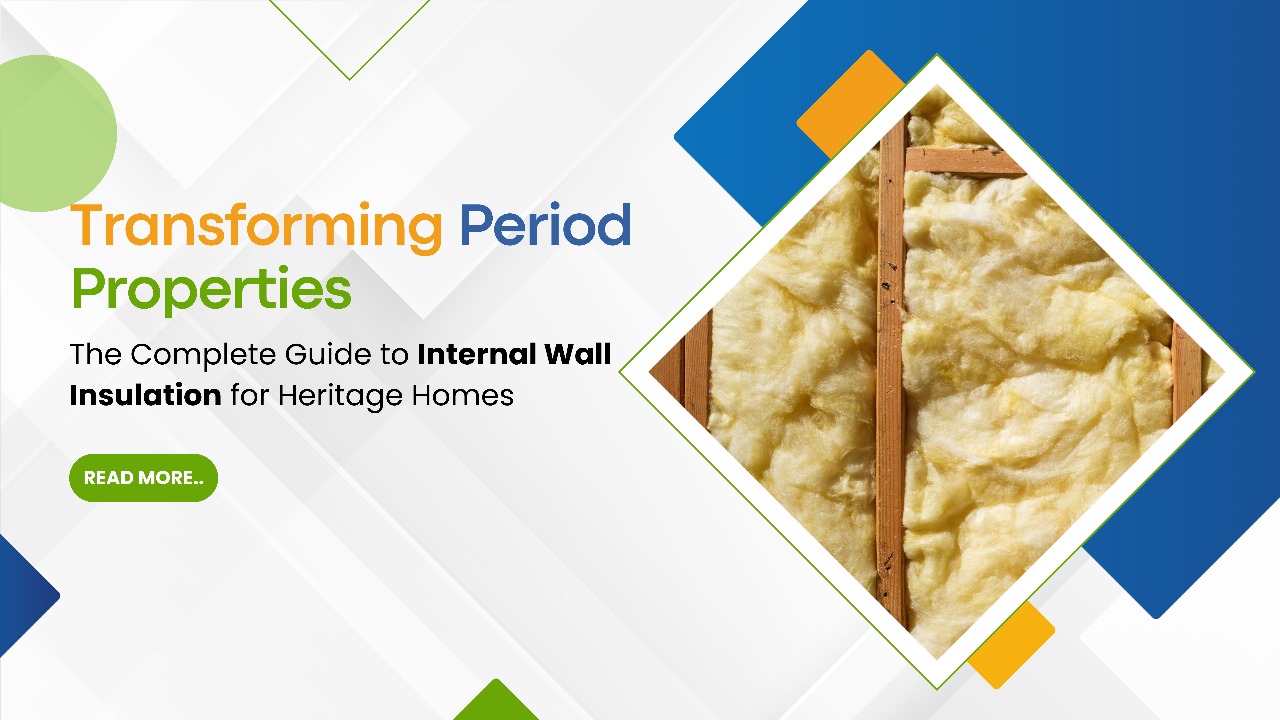
Transforming Period Properties: The Complete Guide to Internal Wall Insulation for Heritage Homes
There's something uniquely charming about period properties. From Victorian terraces to Edwardian semis, these homes boast character and craftsmanship that modern constructions often lack. Yet, behind those beautiful brick facades and elegant sash windows lies a common challenge: solid walls that weren't built to modern energy efficiency standards. If you're tired of choosing between preserving character and achieving comfort, internal wall insulation offers the perfect solution.
Understanding the Solid Wall Challenge
Period properties, typically built before 1920, feature solid wall construction—usually either a single layer of brick or stone, or two layers with no cavity in between. While this construction method has stood the test of time structurally, it presents significant thermal challenges:
The Physics of Heat Loss:
Solid walls act like thermal bridges, continuously transferring heat from inside your home to the outside. Unlike modern cavity walls, which can be filled with insulation, solid walls have no gaps to fill. This means:
- Up to 45% of your heating costs could be escaping through your walls
- Constant battle with cold spots and draughts, regardless of your heating system
- Walls that feel cold to the touch, even when the room air is warm
- Persistent issues with condensation and dampness in colder months
The Comfort Conundrum:
Many period property owners experience:
- Rooms that never feel truly warm, no matter how high you turn up the thermostat
- Significant temperature variations between different parts of the house
- Cold draughts that seem to come from nowhere
- "Thermal shock" when moving from insulated extensions to original rooms
Beyond Energy Bills: The Comprehensive Benefits of Internal Wall Insulation
While reducing heating costs is a significant motivation, the advantages of properly installed internal wall insulation extend much further:
Enhanced Living Comfort:
- Eliminate Cold Bridging: Say goodbye to those mysterious cold spots that make certain areas of rooms uncomfortable
- Consistent Temperatures: Enjoy even warmth throughout your living spaces, from floor to ceiling
- Reduced Draughts: Proper sealing eliminates air leakage around windows, doors, and where walls meet floors
- Warmer Surfaces: Walls that feel warm to touch, making rooms feel cosier even at lower air temperatures
Preservation and Enhancement:
- Character Protection: Unlike external insulation, IWI preserves your home's original external appearance, crucial for listed buildings and conservation areas
- Improved Air Quality: Reduced condensation means less mould and mildew, benefiting allergy sufferers and respiratory health
- Structural Protection: By keeping walls warmer, you reduce the risk of frost damage and damp penetration
- Noise Reduction: The additional mass and airtightness significantly reduce external noise pollution
Financial Advantages:
- Substantial Savings: Typical reductions of 30-45% on heating bills
- Increased Property Value: Improved EPC ratings make your home more attractive to future buyers
- Maintenance Savings: Reduced damp issues mean lower repair and redecoration costs
- Futureproofing: Protection against rising energy prices and potential carbon taxes
Addressing Common Concerns for Period Properties
Many homeowners worry about how insulation might affect their historic home. Here's what you need to know:
"Will it cause damp problems?"
Properly installed, IWI includes vapour control layers and careful detailing to manage moisture. In fact, keeping walls warmer reduces the risk of condensation.
"What about original features?"
Experienced installers can work around and preserve original cornices, fireplaces, and other period features with careful planning and execution.
"Will it make my rooms feel smaller?"
Modern insulation materials are surprisingly slimline. The typical 100mm installation accounts for approximately 2.5% of an average room's volume—a small price to pay for dramatically improved comfort.
"Is it suitable for listed buildings?"
Yes, although it requires careful planning and may require approval from a conservation officer. The internal nature of the work often makes it more acceptable than external alternatives.
The Professional Assessment: What to Expect
Determining if IWI is right for your period property requires expert evaluation. A professional assessment typically includes:
Initial Survey:
- Wall construction analysis and condition assessment
- Identification of existing damp issues or structural concerns
- Measurement of current thermal performance
- Evaluation of existing heating system efficiency
Technical Considerations:
- U-value calculations to determine required insulation thickness
- Condensation risk analysis
- Airtightness strategy development
- Integration with existing services and features
Practical Planning:
- Installation method recommendation (insulation boards vs stud walls)
- Timeline and disruption management planning
- Cost-benefit analysis and funding options review
Making IWI Work in Your Period Home
Successful internal wall insulation in heritage properties requires:
Breathability Considerations:
- Matching insulation materials to your wall's construction type
- Ensuring adequate ventilation is maintained
- Using vapour-permeable materials where appropriate
Detail Design:
- Careful treatment of junctions between walls, floors, and ceilings
- Special attention around windows and doors
- Integration with existing architectural features
Quality Installation:
- Experienced contractors familiar with period properties
- Careful sequencing to minimize disruption
- Ongoing quality checks throughout the process
Transformation: Life After Installation
Homeowners who've installed IWI in their period properties typically report:
Immediate Benefits:
- Noticeable temperature improvement within hours of completion
- Elimination of cold draughts and spots
- Reduced heating system runtime
Long-Term Advantages:
- Consistently lower energy bills year after year
- Improved whole-house comfort
- Better respiratory health for family members
- Enhanced enjoyment of their home's character features
Unexpected Bonuses:
- Quieter living environment due to sound insulation benefits
- Reduced dust circulation from eliminated draughts
- Ability to better enjoy rooms that were previously too cold in winter
Taking the First Step
If you're ready to transform your period property from draughty to delightful, start with a professional assessment. At Zero Carbon Plans, we specialize in helping heritage homeowners navigate the complexities of internal wall insulation while preserving the character that makes your home special.
Don't let another winter pass with you having to choose between character and comfort. Discover how internal wall insulation can help you enjoy the period home you love, with the modern comfort you deserve.
